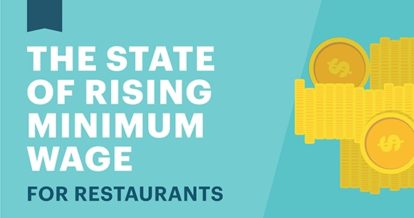If your restaurant needs a loan, your first problem is knowing where to start. Traditional banks, merchant cash advances, and financial tech companies abound, all with their own benefits, barriers, and repayment structures.
Securing a loan for your restaurant can be critical to its success. A loan could mean the difference between adding extra staff to handle an influx of customers or providing a mediocre customer experience. Operating with a restaurant loan under your belt can alleviate some of the stress that comes with owning a restaurant, at least for a little while.
The most important thing to remember about securing a restaurant loan is that you shouldn’t feel backed into a corner if you’re denied a traditional bank loan – there are plenty of alternatives to investigate before you throw in the towel.
This article will shed some light on the requirements for getting a loan, the application process, and common errors restaurateurs make when sourcing money from lenders. First, let’s start with the basics.
Who Can Get a Restaurant Loan?
Any restaurant that’s open can get a loan. While some traditional bank lenders and merchant cash advances may require that a restaurant be open for at least a year, this isn’t always the case. Non-traditional lenders with a long history of underwriting sometimes dispense loans to restaurants that have been open for as little as 30 days.
If you’re still in startup mode, however, you likely can’t borrow money from a lender until your doors have been open for at least a month. Very few lenders are going to provide capital to a restaurant with no financial history due to risk. But this doesn’t mean you’re completely without options: some non-traditional financing companies will fund your restaurant start up if you can demonstrate that you’ve opened a restaurant before.
Why Is It So Difficult for New Restaurants to Get Loans?
Banks ultimately want restaurants to put up collateral to secure a loan. Collateral can come in the form of cash, stocks, or a home or commercial property. But for most restaurant owners who need loans, offering the amount of collateral required for a bank loan just isn’t possible. A bank may ask for $25,000 in collateral in exchange for a $50,000 loan. Most restaurant owners leave thinking, well, if I had $25,000 I could probably get by on that without a loan!
What Do I Do if I Don’t Have Collateral?
Non-traditional lenders sometimes offer the means to “collateralize” a bank loan. In simple terms, the lender will take out a bank loan for you and provide 50% collateral. This allows you to get an unsecured loan because the bank itself is secured with collateral from the alternative financial lender.
So let’s say you’ve made it to the 30-day mark or you’re ready to secure some capital to accelerate your restaurant’s growth. Now the question becomes: which lender do you choose?
Choosing the Right Lender for Your Restaurant Loan
Before you choose a lender for your restaurant loan, you need an understanding of how you’re going to use the money.
Say you’re looking to secure a $600,000 loan. You’re planning to invest half of it in new equipment and the other half in inventory. In this case you’ll want to keep in mind that equipment leasing companies can give you a lower interest rate because they come with collateral: the equipment you want to lease.
The point is: always look for a lender that takes the time to understand you and your business. Take the time to meet with lenders rather than going with the first quick and easy loan you see online. While some online lenders may advertise low interest rates of 3%, this is a monthly rate in most cases. When comparing interest rates, always consider how long you have to pay back the loan. You may have a lower interest rate but a shorter period of time to pay back the loan, so you’ll need to consider what you can handle.
Once you’ve found a lender, whether it’s a traditional bank or non-traditional financial lending company, then comes the process of applying for the loan.
What Does the Restaurant Loan Application Process Look Like?
Some non-traditional lenders will only ask for the essentials. Here are the basic documents you’ll need to apply for a loan with a non-traditional lender:
- The application, which allows the lender to run a credit check
- Three months of bank statements
- Credit card statement
- Documentation pertaining to your restaurant’s partnerships, like a K1 from a tax return
- Federal ID
- Driver’s license
- Void check
The simplicity of the application process is one reason why non-traditional lenders can be appealing to many restaurateurs, who may not want to spend the time to pull together a lot of documentation only for their loan to be rejected and their time wasted.
Banks require more information for a loan application. In addition to the documentation listed above, a business owner needs to submit the following:
- Two years of tax returns
- Year-to-date financials
- Business plan
- Personal financials
- List of all other loans
- Bank statements
Once the application is submitted with a non-traditional lender, it goes into underwriting, which can take less than two days. During that time, the lender will call the guarantor and landlords for an interview. Assuming everyone answers their phone, it’s possible to complete the process from start to finish in 5-7 days.
Loan Repayment Structures
Traditional bank loans often require monthly payments, whereas other lenders may request a weekly payment. Some merchant cash advances may even require a daily payment, which is difficult to keep up with. Some lenders go so far as to garnish a percentage of credit card sales.
Make sure to understand the terms of your loan before you sign on. The restaurant industry, due to its risky nature, is subject to a lot of short-term loans, as most lenders want to the loan agreement to end within a year. Keep an eye out for lenders that make it possible to secure loans over a longer 12-24 month term, which provides more leeway.
Common Mistakes with Restaurant Loans
When a restaurateur needs a loan to secure their business, it’s tempting to ignore best practices and make mistakes. Here are some mistakes to avoid when looking to secure financing for your restaurant.
1. Succumbing to a sales pitch
Be wary of agents who are aggressive and promise things they can’t deliver. Some agents pressure restaurateurs into taking a loan that isn’t right for their business or, worse, too much money for what they need. Make sure the agent you’re dealing with approaches you in a consultative manner, so that you’re securing the right restaurant financing.
2. Stacking cash advances
Whatever you do, don’t take out multiple merchant cash advances. Merchant cash advances can bury restaurant owners in high interest.
3. Waiting too long to secure a line of credit
Set up your line of credit set up before you need it – because once you need it, it might be harder to get. Don’t wait until you’re desperate, because you’re more likely to be turned down if you are.
4. Dipping into personal finances
It’s common for many restaurant owners to refinance their homes or dip into their 401K for capital for their restaurant. One of the top rules of business is that you avoid using your own money to fund your business unless you have money set aside that is just for that.
Remember that successful restaurants are those that have great operational discipline. Running a restaurant is an expensive endeavor, but with the right financial strategy, you can be in business for years to come.
Download our free inventory template
Sign up for our free weekly TouchBistro Newsletter







